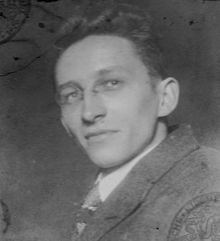August Oppenberg
August Oppenberg (actually August Heinrich Oppenberg; born January 7, 1896 in Bochum , † August 16, 1971 in Schermbeck ) was a German painter .
August Oppenberg was born in Bochum in 1896, where his father had been temporarily transferred for professional reasons. At the age of 9 he, his parents and siblings went back to the ancestral home of the Oppenberg family on the Fusternberg, previously part of Feldmark Wesel, after completion of the new residential building at Am Lilienveen 13/1 (after reorganization 36). After finishing secondary school, Oppenberg worked for the Wesel city administration until he was drafted as an artilleryman during the First World War from 1915 to 1918. After the war Oppenberg worked for the administration of the then independent municipality Obrighoven-Lackhausen (now a district of Wesel) and studied at the same time at the School of Applied Arts in Dusseldorf . From 1924 Oppenberg worked as a freelance artist and became friends with the poet Erich Bockemühl , whose works were mostly to be illustrated by Oppenberg in the following. A lasting friendship also grew with Otto Pankok . After his participation in the “Great Westphalian Art Exhibition” in Dortmund in 1926, Oppenberg's first own exhibition followed in 1927 in the “Städtisches Museum” in Mülheim an der Ruhr and further exhibitions in the Rhineland and Westphalia, later in the entire German Empire and from 1930 also in Amsterdam , Florence , Paris and Vienna . In 1934 Oppenberg became a co-founder of the "Association of Lower Rhine Artists and Art Friends". Due to the destroyed infrastructure of Wesel due to the almost complete destruction of the Second World War , Oppenberg, his mother and siblings moved to Drevenack, after the war he returned to his parents' house "Am Lilienveen" in Wesel and died in 1971 in the Schermbeck hospital. He was buried in the cemetery on Caspar-Baur-Straße . In the district of Fusternberg in the area of Lilienveen a street was named after him.
In addition to numerous graphic illustrations of the works of Bockemühl, Oppenberg made landscape paintings and pictures of farm work, which earned him the nicknames "Painter of the Lower Rhine" and "Peasant painter". On the occasion of Oppenberg's 60th birthday, Bockemühl wrote about him: “The farm work, which includes humans and animals, became almost instinctively new to him. He became the painter of peasant work, but in a way in which the actions of the people were primarily linear, as was the case with many Dutch painters of bygone times, with the landscape in a rare form and quite personally and objectively. "
In total, he created around 3600 works in his five-decade creative period, around 2/3 of them in black and white
His grave is in the old Wesel cemetery on Caspar Baur Strasse in Wesel.
Web links
- Literature by and about August Oppenberg in the catalog of the German National Library
- Drawings and paintings by Oppenberg
| personal data | |
|---|---|
| SURNAME | Oppenberg, August |
| ALTERNATIVE NAMES | Oppenberg, August Heinrich (real name) |
| BRIEF DESCRIPTION | German painter |
| DATE OF BIRTH | January 7, 1896 |
| PLACE OF BIRTH | Bochum |
| DATE OF DEATH | 16th August 1971 |
| Place of death | Schermbeck |
